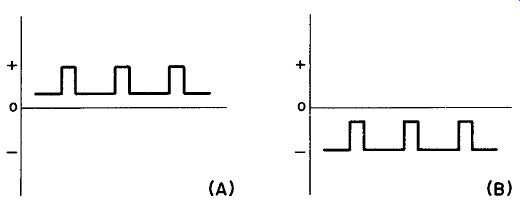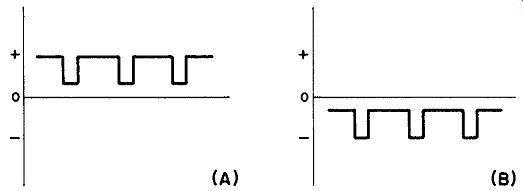AMAZON multi-meters discounts AMAZON oscilloscope discounts
1. What a Multivibrator is
There was a time when the word "multivibrator" referred only to a free-running, square-wave oscillator used to produce harmonics and subharmonics for test purposes. Today the term carries a much deeper and broader significance. Multivibrators are found in tele vision, radar, computers, long distance communications systems, diversity receiving equipment, electronic switches, radio-control, stroboscopes, cathode-ray oscilloscopes, and an incredibly large number of other specialized devices.
A multivibrator is a type of relaxation oscillator [1] employing a two-stage amplifier, with the output of the second stage regenerative coupled to the input of the first stage. However, within these limits there are different types. These types differ somewhat in circuitry and considerably in function.
[ 1. A relaxation oscillator may be defined as an oscillator in which one or more voltages or currents change abruptly and periodically to produce, as a rule, a non-sinusoidal waveform. Relaxation oscillations are generally obtained by utilizing· the time delay of capacitive charge or discharge through a resistor. ]
Various terms have been used in the past to distinguish them. Some of these terms are in consistent, some ambiguous or indefinite. In this book, each important type is discussed in a separate section. The latest accepted terms are used in referring to these types, and each section heading is the proper term for the type discussed m that section. These heading are:
Bi-stable Multivibrator ( Section 2)
Mono-stable Multivibrator ( Section 3)
A-stable Multivibrator ( Section 4)
Other popular terms, less authoritative or definitive, will also be explained later, to help the reader recognize them.
2. Definitions
Before beginning the discussion and analysis of multivibrator circuits, it is necessary to define some of the terms that will be used in subsequent sections.
Multivibrator. A type of relaxation oscillator consisting basic ally of a two-stage resistance-coupled amplifier whose output is coupled regeneratively to its input. Types differ mainly in methods of coupling. The type of coupling use influences mode of operation. The outstanding feature of multivibrator operation is that electrical operation can be rapidly changed from one to the other of two states. These two states are:
(a) conduction in tube 1 and cutoff in tube 2, and (b) conduction in tube 2 and cutoff in tube 1.
Stable state. Electrical state in which a multivibrator remains indefinitely, unless the circuit is acted upon from an external source (for example, by a trigger voltage). A-stable Multivibrator. A multivibrator in which neither of the two tubes reaches a stable state during operation, hence a circuit capable of free-running oscillation caused by self-excitation.
The circuit continually alternates between one state and the other at a definite rate, determined by circuit constants. In the past, this circuit has been referred to merely as a "multivibrator." Bi-stable Multivibrator. A multivibrator in which either tube becomes stable in either one of its states. The circuit locks in either condition and remains that way until reversed by the application of a suitable external excitation pulse.
Mono-stable Multi-vibrator. A multivibrator in which only one of the two states can become stable. The circuit returns itself to its normal stable state after it has been temporarily shifted to the other state by application of an external excitation pulse.
Some other names, not as specific or authoritative, but some times applied to the different multivibrator circuits are as follows:
A-Stable Multivibrator. Free-running multivibrator.
Bi-Stable Multivibrator. Binary, binary counter, locking circuit, frequency divider, repeater, regenerator, flop-over circuit, Eccles-Jordan trigger circuit.
Mono-Stable Multivibrator. One-shot multivibrator, flip-flop.
3. Pulse Formation
If the reader clearly understands how pulses are formed in vacuum tube circuits, a study of multivibrators is easier. The following points constitute a brief review of some of the primary actions in simple pulse circuits.
a. A positive-going pulse is one that "rises" toward its maxi mum (most positive) value in a positive direction, regardless of the polarity of the absolute value of the voltage during the pulse.
For example, pulses at both (A) and (B) of Fig. 1 are positive going, even though the absolute value of the voltage at (B) never becomes positive.
b. A negative-going pulse is one that "rises" to its maximum (most negative) value in a negative direction, regardless of the polarity of the absolute value of the voltage during the pulse. For example, pulses at (A) and (B) of Fig. 2 are both negative-going, even though at (A) the absolute value of the voltage never becomes negative.
c. A sudden rise in plate current in a vacuum tube yields a negative-going voltage pulse at the plate (between plate and cathode). Similarly, a sudden drop in plate current results in a positive going plate voltage pulse. [2]
d. A negative-going voltage pulse applied to the grid of a tube yields a positive-going voltage pulse at the plate; a positive-going grid voltage pulse produces a negative-going plate voltage pulse.
e. Coupling capacitors do not change the direction of rise of the coupled pulse; the same applies to coupling resistors.
f. A negative-going voltage pulse applied to the cathode of a tube causes a negative-going voltage pulse to appear at the plate; a positive-going pulse on the cathode yields a positive-going plate pulse.
[ 2. The plate voltage is equal to the value of the B-supply minus the drop in the plate resistor. As plate current increases, the voltage drop in the plate resistor increases, and thus plate voltage decreases. ]

Fig. 1. Examples of "positive-going" pulses.
Multivibrator circuits have two important properties that lead to many valuable applications. The first is the abrupt waveform generated; i.e., somewhere in the circuit there is a very rapid change of voltage with time, say of the order of 100 volts per microsecond.
This allows the circuits to be used where high resolutions in time are to be effected, as in accurate time measurements, in time modulation circuits, in pulse counting apparatus, and in frequency division. The second property of the multivibrator is its ability to generate square waves. Not only is the rise and flyback time very short, but the circuit remains in one state for a relatively long time so that the output is substantially constant over the interval between transitions. This output can be used to turn another circuit on or off, a process called "gating." There are many applications of "gates" of this nature. Such a gate can be used to turn on or off a tube for a definite time sequence relative to the rest of the circuit. For example, a sweep can be started, a pulse appearing in a certain time interval can be counted or rejected, a cathode ray tube can be blanked, or a receiver can be made inoperative. The time over which this constancy of output appears may be measured in seconds, milliseconds, or microseconds, so flexible is the circuit.
In some multivibrators, the width (length of flat top of square wave) is governed by the voltage at some point in the circuit or by the value of some circuit parameter. This suggests a host of applications, such as time modulation, coding, and others involving definite time sequence.
4. Multivibrator Action

Fig. 2. Examples of "negative-going" pulses.
The voltage on a capacitor cannot change instantaneously. If there is to be an abrupt change in voltage between any two points in a circuit, the capacitive loading between these points must be as low as possible. For a given capacitance, the change in voltage in a given time is proportional to the charge delivered in this time and hence to the current. Thus large charging and discharging currents are prime requisites of abrupt waveforms. These sudden changes are initiated by turning a tube off or on. Doing this calls for tubes that have a very steep transfer characteristic; that is, the change in plate current for a given change in grid voltage is large (a high value of transconductance).
Throughout many of the discussions to follow, the terms "on" and "off" will be used to describe the state of a tube. Caution must be exercised at this time to be consistent about the meanings of these words as used in the text. When a tube is described as "on" or "full-on," this means that the tube is conducting with its cathode-grid voltage essentially at zero or at such a value that the plate circuit is fully conductive. Then a tube is described as "off," it is to be taken as being at the cutoff point with no plate current flowing at all.
5. QUIZ
(1) Give six electronic applications of multivibrator circuits.
(2) Define: multivibrator, a-stable multivibrator, bi-stable multivibrator, and mono-stable multivibrator.
(3) What is meant by a "stable state" in a multivibrator?
(4) List four salient points in pulse formations.
(5) What is meant by a "negative-going pulse"?
(6) What is gating?
(7) Why is a high-transconductance tube desirable for steep waveform?
(8) What is meant by the terms "on" or "off' with respect to a tube operating as a multivibrator?